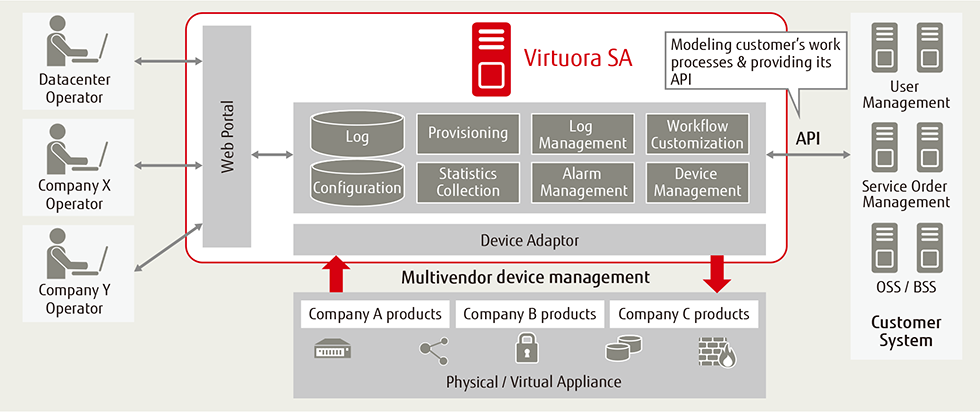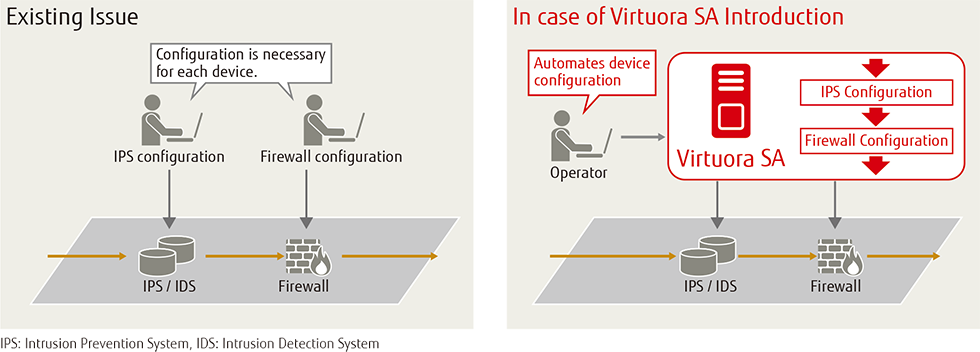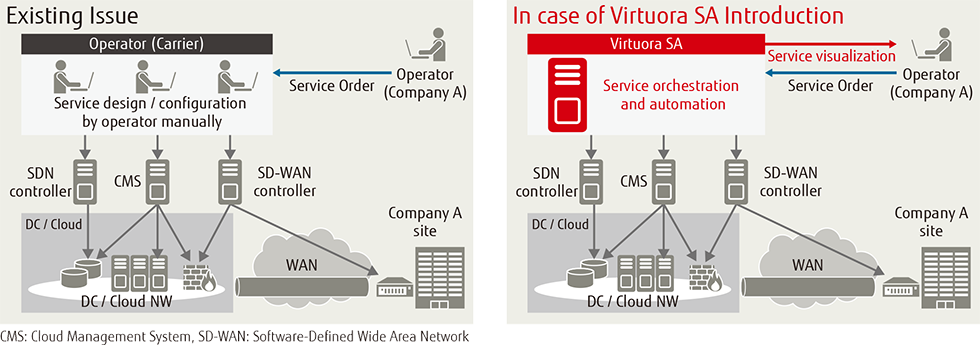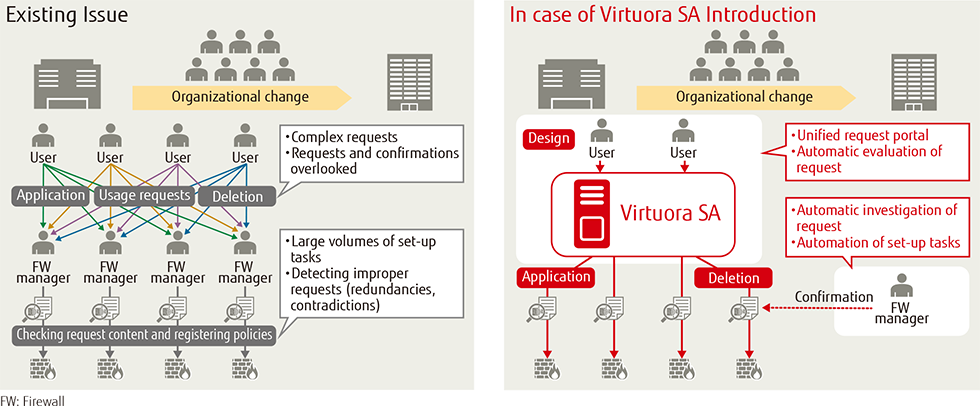Archived content
NOTE: this is an archived page and the content is likely to be out of date.
FUJITSU Network Virtuora SA powered by UBiqube
Overview of Virtuora SA powered by UBiqube
- Virtuora SA powered by UBiqube (Virtuora SA) (*1) is a service orchestration software that delivers integrated operation management of various network and security devices (including virtual appliances) and various services.
- Network complexity is growing along with the implementation of new software-defined networking (SDN) and network functions virtualization (NFV) technologies. Development of new services such as cloud, managed security and Internet of Things (IoT) are dependent on these technologies and yet customers are challenged with managing numerous physical devices or virtualized resources in multi-vendor environments.
- Virtuora SA abstracts the operations differences between various vendors and services by modeling (*2) the customer's service integration, operation management, and/or security management and providing its API. Customers can shorten the service introduction period and reduce operating costs.
(*1) Virtuora SA is Fujitsu's software package built on UBiqube’s software "MSActivator™".
(*2) Modeling: Extract common and necessary items in customer's processes and simplify configurations.
Advantages of Virtuora SA powered by UBiqube
Advantages 1: Automation of customer work by workflow customization
- Customers can automate their processes by programming each task, like a manually configured firewall, and incorporate that task it into a workflow control as a component.
- Customers can automate their various work flows quickly and easily by combining task components.
Advantages 2: Abstracting the vendor systems of each device with technology modeling
- By registering an API command that controls devices (e.g. IPS / IDS) and system information (e.g. IP address) as a device adaptor files and modeling it, the operator can manage various devices and systems the same way, without being aware of differences in vendor and system.
- Even when it is necessary to change the interface specifications, like the next version of the device software, the operator does not need to change the process; they need only change the device adaptor file.
Advantages 3: Automatic execution of action according to operational policy configuration
- By collecting and analyzing IPS / IDS logs and registering actions in advance (like isolating infected PCs in the workflow when a change in operation state that might be attributed to illegal communication caused by malware attack is detected) according to the operation policy configuration. Appropriate actions can be executed automatically.
- By monitoring logs and operating manually by the operator whenever an error occurs will not be necessary.
Use Case 1: Service orchestration over clouds and networks including SD-WAN
- When company customers order cloud service, it is necessary for the operator to execute service design and various systems configuration such as DC network and WAN, which can be a lengthy manual process.
- With Virtuora SA, these operations can be simplified and automated by interconnecting these systems. Thus, service lead time can be significantly reduced. Furthermore, the company operator can operate easily by their own.
Use Case 2: Automating customer operations across organizations and affiliates
- When enterprise organizations change, and personnel changes, various policy changes related to security devices is necessary. In the past, each organization was responsible for equipment, and the amount of configuration change increased based on the number of exceptions.
- With Virtuora SA, companies can have unified operations across organizations and related companies. By automating policy configuration tasks, costs can be significantly reduced, regardless of the scale of the changes.
Summary of Requirements
| Hardware | CPU | Intel® Xeon® (16cores) or higher |
|---|---|---|
| Memory | 128GB or higher | |
| Storage | 650GB or higher | |
| Ethernet Card | 1000BASE-T 2ports or higher | |
| OS | Red Hat Enterprise Linux 7.2 (for Intel64) | |
- UBiqube and MSActivator are trademarks or registered trademarks of UBiqube PLC.
- Intel, Xeon and Intel Core are trademarks or registered trademarks of Intel Corporation in the United States and/or other countries.
- Ethernet is a trademark or registered trademarks of Xerox.
- Linux is a trademark or registered trademarks of Linus Torvalds.
- Red Hat and Red Hat Enterprise Linux are trademarks or registered trademarks of Red Hat Inc., registered in the United States and/or other countries.
- All company names, brand names, and product names described here are the trademarks or registered trademarks of their respective holders.
The information here is subject to change without notice.
Documentation
- FUJITSU Network Virtuora SA (316 KB)





